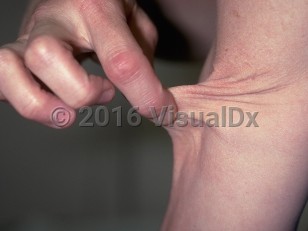Classification:
- Hypermotility (type 3): The most common type (affecting 1 in 10-15 000); symptoms include marked joint hypermotility, instability, and chronic joint pain, but with minimal skin hyperextensibility and scar formation.
- Classical (types 1 and 2): Affecting fewer than 1 in 20-40 000 people; symptoms include hyperextensible, velvety, fragile skin with bruisability and poor wound healing. Nodules are common on the knees and elbows. Joints are hypermobile and prone to dislocation. Pregnancy can be life-threatening.
- Vascular (type 4): Estimated 1 in 100-200 000 people affected; this is one of the most serious subtypes, and patients often have a shortened lifespan secondary to arterial, uterine, or intestinal rupture. Characterized by thin, translucent skin with prominent veins and extensive bruising, and joint hypermotility limited to the digits. Spontaneous rupture of mid- to large-size arteries can occur in childhood, although this most often occurs in the third or fourth decade. Distinctive facial features include protruding eyes, thin nose and lips, small chin, and sunken cheeks. There is significant risk in surgery due to poor wound healing and bleeding. Carotid-cavernous sinus fistula occurs in 10% of these patients; sudden blurred vision and ocular pain occur. Rapid intervention is needed to preserve the patient's vision.
- Kyphoscoliosis (type 6): Uncommon, with fewer than 60 cases worldwide; symptoms include scoliosis, progressive muscular weakness, and ocular, especially scleral, fragility.
- Arthrochalasia (types 7 A and B): Rare, with 30 cases worldwide; symptoms include joint hypermobility with dislocations (including the hips), hyperextensible skin, and early-onset osteoarthritis with increased risk of bone fracture.
- Dermatosparaxis (type 7 C): Very rare, with 10 cases worldwide; symptoms include joint laxity and hypermotility, often leading to delayed large-motor skills in children. Patients also have skin fragility with loss of elasticity.
- Type 5: Skin fragility, but without significant bruising or joint hypermotility.
- Type 8: Periodontal form leading to early periodontal disease with associated skin and joint hyperextensibility.
- Type 9: Removed from the EDS classification, now known as Menkes syndrome.
- Type 10 and 11: Similar to mild classical EDS. Type X is fibronectin deficient type leading to clotting defects from abnormal platelet aggregation.
Related topic: cystic medial necrosis



